The Role of Regional Codes in Mitigating Residential Sector Energy Demand Sensitivity to Climate Change Scenarios in Hot–Arid Regions
Abstract
1. Introduction
1.1. Objective, Research Questions, and Significance
- To quantify and compare the energy consumption and cooling load increases in the Noor City and Banan City case studies under projected climate scenarios.
- To assess the extent to which the regional building codes and design standards in Egypt and Saudi Arabia influence these projected increases.
- To provide actionable insights and design recommendations for developers and policymakers aiming to enhance the energy resilience of residential buildings in the Middle East.
- How will climate change affect the energy consumption and cooling loads of residential buildings in Cairo and Riyadh by 2050 and 2080?
- To what extent do regulatory differences contribute to the projected increase in energy demand in Noor City buildings compared to Banan City buildings under future climate scenarios?
- What design and regulatory strategies could be implemented to reduce future energy demands and enhance building resilience in both regions?
1.2. Research Scope
2. Literature Review
2.1. Energy Demand in Residential Buildings
2.2. Impact of Climate Change on Building Energy Performance
2.3. Influence of Contemporary Building Codes on Energy Performance Under Future Climate Scenarios
2.4. Building Codes and Regulations in Saudi Arabia and Egypt
| Building Code | Areas | Properties of the Building Envelope | |||||
|---|---|---|---|---|---|---|---|
| U-Value (W/m2·K) | SHGC | ||||||
| Walls | Roofs | Windows | Glazing | ||||
| Façade Area < 40% | Façade Area 40:50% | Façade Area > 50% | |||||
| Saudi Arabia | Riyadh | 0.454 | 0.272 | 2.89 | 2.38 | 1.87 | 0.25 |
| Egypt | Cairo * | - | - | - | - | - | - |
3. Methodology
3.1. Case Study Description
3.2. Simulation Tools and Data Sources
4. Results and Discussion
4.1. Current and Future Weather Data Analysis
4.2. Validation of Simulation Models
4.3. Current Weather Data Scenario Comparison
4.4. The 2050 Weather Data Scenario
4.5. The 2080 Weather Data Scenario
4.6. Code-Swapping Scenarios: Isolating the Influence of Building Codes
4.7. Discussion of the Results
4.7.1. Seasonal Energy and Cooling Load Variations
4.7.2. Impact of Projected Climate Scenarios for 2050 and 2080
4.8. National Increase in Energy Demand and Associated Carbon Emissions
5. Actionable Insights and Recommendations
5.1. Impact on Building Codes and Insulation
5.2. Lack of Renewable Energy Integration in Design Codes
6. Conclusions
Author Contributions
Funding
Data Availability Statement
Conflicts of Interest
Nomenclature
| ACH | Air changes per hour |
| COP | Coefficient of Performance |
| GPRS | Green Pyramid Rating System |
| RCP | Representative Concentration Pathway |
| IPCC | Intergovernmental Panel on Climate Change |
| SBC | Saudi Building Code |
| SEEC | Saudi Energy Efficiency Center |
| WWR | Window-to-wall ratio |
References
- Lipson, M.J.; Thatcher, M.; Hart, M.A.; Pitman, A. Climate change impact on energy demand in building-urban-atmosphere simulations through the 21st century. Environ. Res. Lett. 2019, 14, 125014. [Google Scholar] [CrossRef]
- Bazazzadeh, H.; Nadolny, A.; Safaei, S.S.H. Climate Change and Building Energy Consumption: A Review of the Impact of Weather Parameters Influenced by Climate Change on Household Heating and Cooling Demands of Buildings. Eur. J. Sustain. Dev. 2021, 10, 1. [Google Scholar] [CrossRef]
- BP. BP Statistical Review of World Energy 2021, 70th ed.; BP p.l.c.: London, UK, 2021. [Google Scholar]
- Allouhi, A.; El Fouih, Y.; Kousksou, T.; Jamil, A.; Zeraouli, Y.; Mourad, Y. Energy consumption and efficiency in buildings: Current status and future trends. J. Clean. Prod. 2015, 109, 118–130. [Google Scholar] [CrossRef]
- Li, Y.L.; Han, M.Y.; Liu, S.Y.; Chen, G.Q. Energy consumption and greenhouse gas emissions by buildings: A multi-scale perspective. Build. Environ. 2019, 151, 240–250. [Google Scholar] [CrossRef]
- Seyedzadeh, S.; Rahimian, F.P.; Glesk, I.; Roper, M. Machine learning for estimation of building energy consumption and performance: A review. Vis. Eng. 2018, 6, 5. [Google Scholar] [CrossRef]
- Felimban, A.; Prieto, A.; Knaack, U.; Klein, T.; Qaffas, Y. Assessment of Current Energy Consumption in Residential Buildings in Jeddah, Saudi Arabia. Buildings 2019, 9, 163. [Google Scholar] [CrossRef]
- Al-Homoud, M.S.; Krarti, M. Energy efficiency of residential buildings in the kingdom of Saudi Arabia: Review of status and future roadmap. J. Build. Eng. 2021, 36, 102143. [Google Scholar] [CrossRef]
- Hegazy, I.R. Toward efficient energy consumption in middle income housing buildings in Egypt. Int. J. Low-Carbon Technol. 2020, 15, 180–189. [Google Scholar] [CrossRef]
- Sheta, W.W. The potential of residential energy standards in Egypt: A comparative study with the code for sustainable homes. J. Al-Azhar Univ. Eng. Sect. 2018, 13, 1608–1616. [Google Scholar] [CrossRef]
- Alrashed, F.; Asif, M. Prospects of Renewable Energy to Promote Zero-Energy Residential Buildings in the KSA. Energy Procedia 2012, 18, 1096–1105. [Google Scholar] [CrossRef]
- Allah, H.; Khalil, E.E. Energy Efficiency Strategies in Urban Planning of Cities. In Proceedings of the 7th International Energy Conversion Engineering Conference, Denver, CO, USA, 2–5 August 2009. [Google Scholar] [CrossRef]
- Al-Razaz, Z.M.; Lotfy, M.Y.; Bakr, H. Measuring The Efficiency Of Applying Passive Design Strategies To A Residential prototype In Egypt. J. Al-Azhar Univ. Eng. Sect. 2021, 16, 362–374. [Google Scholar] [CrossRef]
- TMG. Noor Smart City—Capital Gardens|TMG. Available online: https://talaatmoustafa.com/communities/noor-city-capital-gardens/ (accessed on 18 November 2024).
- TMG. Banan|A New Landmark in the Capital Al Riyadh. 2024. Available online: https://talaatmoustafa.sa/en/banan-al-riyadh (accessed on 18 November 2024).
- Elnaklah, R.; Alnuaimi, A.; Alotaibi, B.S.; Topriska, E.; Walker, I.; Natarajan, S. Thermal comfort standards in the Middle East: Current and future challenges. Build. Environ. 2021, 200, 107899. [Google Scholar] [CrossRef]
- Aloshan, M.; Aldali, K. Empirical study of facade retrofits for optimizing energy efficiency and cooling in school buildings in Saudi Arabia. Energy Rep. 2024, 12, 4105–4128. [Google Scholar] [CrossRef]
- Mahmoud, H.; Ragab, A. Impact of Urban Geometry on Cooling Loads in Egypt: Case study: A social residential compound in New Aswan City. In Proceedings of the 2020 9th International Conference on Power Science and Engineering (ICPSE), London, UK, 23–25 October 2020; pp. 71–75. [Google Scholar] [CrossRef]
- Elnabawi, M.H. Evaluating the Impact of Energy Efficiency Building Codes for Residential Buildings in the GCC. Energies 2021, 14, 8088. [Google Scholar] [CrossRef]
- Alyami, S.H.; Alqahtany, A.; Ashraf, N.; Osman, A.; Aldossary, N.A.; Almutlaqa, A.; Al-Maziad, F.; Alshammari, M.S.; Al-Gehlani, W.A.G. Impact of Location and Insulation Material on Energy Performance of Residential Buildings as per Saudi Building Code (SBC) 601/602 in Saudi Arabia. Materials 2022, 15, 9079. [Google Scholar] [CrossRef]
- Almasri, R.A.; Alardhi, A.A.; Dilshad, S. Investigating the Impact of Integration the Saudi Code of Energy Conservation with the Solar PV Systems in Residential Buildings. Sustainability 2021, 13, 3384. [Google Scholar] [CrossRef]
- Gamaleldine, M.; Corvacho, H. Compliance with Building Energy Code for the Residential Sector in Egyptian Hot-Arid Climate: Potential Impact, Difficulties, and Further Improvements. Sustainability 2022, 14, 3936. [Google Scholar] [CrossRef]
- Kutty, N.A.; Barakat, D.; Darsaleh, A.O.; Kim, Y.K. A Systematic Review of Climate Change Implications on Building Energy Consumption: Impacts and Adaptation Measures in Hot Urban Desert Climates. Buildings 2024, 14, 13. [Google Scholar] [CrossRef]
- Bampou, P. Green buildings for Egypt: A call for an integrated policy. Int. J. Sustain. Energy 2017, 36, 994–1009. [Google Scholar] [CrossRef]
- Al-Saeed, Y.W.; Ahmed, A. Evaluating Design Strategies for Nearly Zero Energy Buildings in the Middle East and North Africa Regions. Designs 2018, 2, 35. [Google Scholar] [CrossRef]
- Ebekozien, A.; Aigbavboa, C.; Thwala, W.D.; Amadi, G.C.; Aigbedion, M.; Ogbaini, I.F. A systematic review of green building practices implementation in Africa. J. Facil. Manag. 2024, 22, 91–107. [Google Scholar] [CrossRef]
- Fereidani, N.A.; Rodrigues, E.; Gaspar, A.R. A review of the energy implications of passive building design and active measures under climate change in the Middle East. J. Clean. Prod. 2021, 305, 127152. [Google Scholar] [CrossRef]
- Aram, K.; Taherkhani, R.; Šimelytė, A. Multistage Optimization toward a Nearly Net Zero Energy Building Due to Climate Change. Energies 2022, 15, 983. [Google Scholar] [CrossRef]
- Abuhussain, M. An Assessment of the Saudi Residential Buildings Envelope Code Under the Current and Future Climate Change Scenarios: The Case for Jeddah in the Hot and Humid Climate Region. Ph.D. Thesis, University of Liverpool, Liverpool, UK, 2020. [Google Scholar] [CrossRef]
- Ahmed, W.; Asif, M. A critical review of energy retrofitting trends in residential buildings with particular focus on the GCC countries. Renew. Sustain. Energy Rev. 2021, 144, 111000. [Google Scholar] [CrossRef]
- Alsaqabi, Y.; Almhafdy, A.; Haider, H.; Ghaffarianhoseini, A.; Ghaffarianhoseini, A.; Ali, A.A.M.M. Techno-Environmental Assessment of Insulation Materials in Saudi Arabia: Integrating Thermal Performance and LCA. Buildings 2023, 13, 331. [Google Scholar] [CrossRef]
- Allard, I.; Nair, G.; Olofsson, T. Energy performance criteria for residential buildings: A comparison of Finnish, Norwegian, Swedish, and Russian building codes. Energy Build. 2021, 250, 111276. [Google Scholar] [CrossRef]
- Deng, Z.; Javanroodi, K.; Nik, V.M.; Chen, Y. Using urban building energy modeling to quantify the energy performance of residential buildings under climate change. Build. Simul. 2023, 16, 1629–1643. [Google Scholar] [CrossRef]
- Khalil, E.E. An International Outlook of Innovative Energy Efficient Designs of Low Carbon Buildings. In Proceedings of the ASME International Mechanical Engineering Congress and Exposition, Proceedings (IMECE), San Diego, CA, USA, 15–21 November 2013; Volume 11. [Google Scholar] [CrossRef]
- Issa, N.S.C.; Al Abbar, S.D. Sustainability in the Middle East: Achievements and challenges. Int. J. Sustain. Build. Technol. Urban Dev. 2015, 6, 34–38. [Google Scholar] [CrossRef]
- Elfiky, U. Towards a green building law in Egypt: Opportunities and challenges. Energy Procedia 2011, 6, 277–283. [Google Scholar] [CrossRef]
- Alfaraidy, F.A.; Azzam, S. Residential Buildings Thermal Performance to Comply with the Energy Conservation Code of Saudi Arabia. Eng. Technol. Appl. Sci. Res. 2019, 9, 3949–3954. [Google Scholar] [CrossRef]
- Mahdy, M.; Fahmy, M.; Elwy, I. Solid Parts And Fenestration in Building Envelope Are They Working in Series or in Parallel Under Climate Change—Study in Egypt. In Proceedings of the International Conference on Civil and Architecture Engineering 2016, Cairo, Egypt, 19–22 April 2016; Volume 11, pp. 1–31. [Google Scholar] [CrossRef]
- Anber, M.; Khalifa, R. Thermal Performance of Building Envelope in Residential Buildings in New Administrative Capital in Egypt. Int. Des. J. 2022, 12, 21–28. [Google Scholar] [CrossRef]
- Saudi Building Code National Committee. Suadi Building Code. Available online: https://www.sbc.gov.sa/en/Pages/default.aspx (accessed on 26 February 2025).
- Aloshan, M.A. Achieving near-zero energy in hot climates: Retrofitting building envelopes for existing homes. Heliyon 2025, 11, e42170. [Google Scholar] [CrossRef] [PubMed]
- Standards 62.1 & 62.2. Available online: https://www.ashrae.org/technical-resources/bookstore/standards-62-1-62-2?utm_source=chatgpt.com (accessed on 24 April 2025).
- Jentsch, M.F.; Bahaj, A.B.S.; James, P.A.B. Climate change future proofing of buildings—Generation and assessment of building simulation weather files. Energy Build. 2008, 40, 2148–2168. [Google Scholar] [CrossRef]
- Weather Data Center. Available online: https://www.ashrae.org/technical-resources/bookstore/weather-data-center (accessed on 1 March 2025).
- Aldossary, N.A.; Rezgui, Y.; Kwan, A. Establishing domestic low energy consumption reference levels for Saudi Arabia and the Wider Middle Eastern Region. Sustain. Cities Soc. 2017, 28, 265–276. [Google Scholar] [CrossRef]
- Umbark, M.A.; Alghoul, S.K.; Dekam, E.I. Energy Consumption in Residential Buildings: Comparison between Three Different Building Styles. Sustain. Dev. Res. 2020, 2, 1–8. [Google Scholar] [CrossRef]
- The Ministry of Electricity and Renewable Energy. Available online: http://www.moee.gov.eg/english_new/home.aspx (accessed on 13 May 2025).
- Ministry of Energy. Available online: https://www.moenergy.gov.sa/ (accessed on 13 May 2025).
- Ruchpaul, R.S.; Shamachurn, H. Performance Comparison of three PV Technologies under the Effect of Partial Shading and Varying Tilt Angles. J. Electr. Eng. Electron. Control Comput. Sci. 2020, 6, 9–18. [Google Scholar]
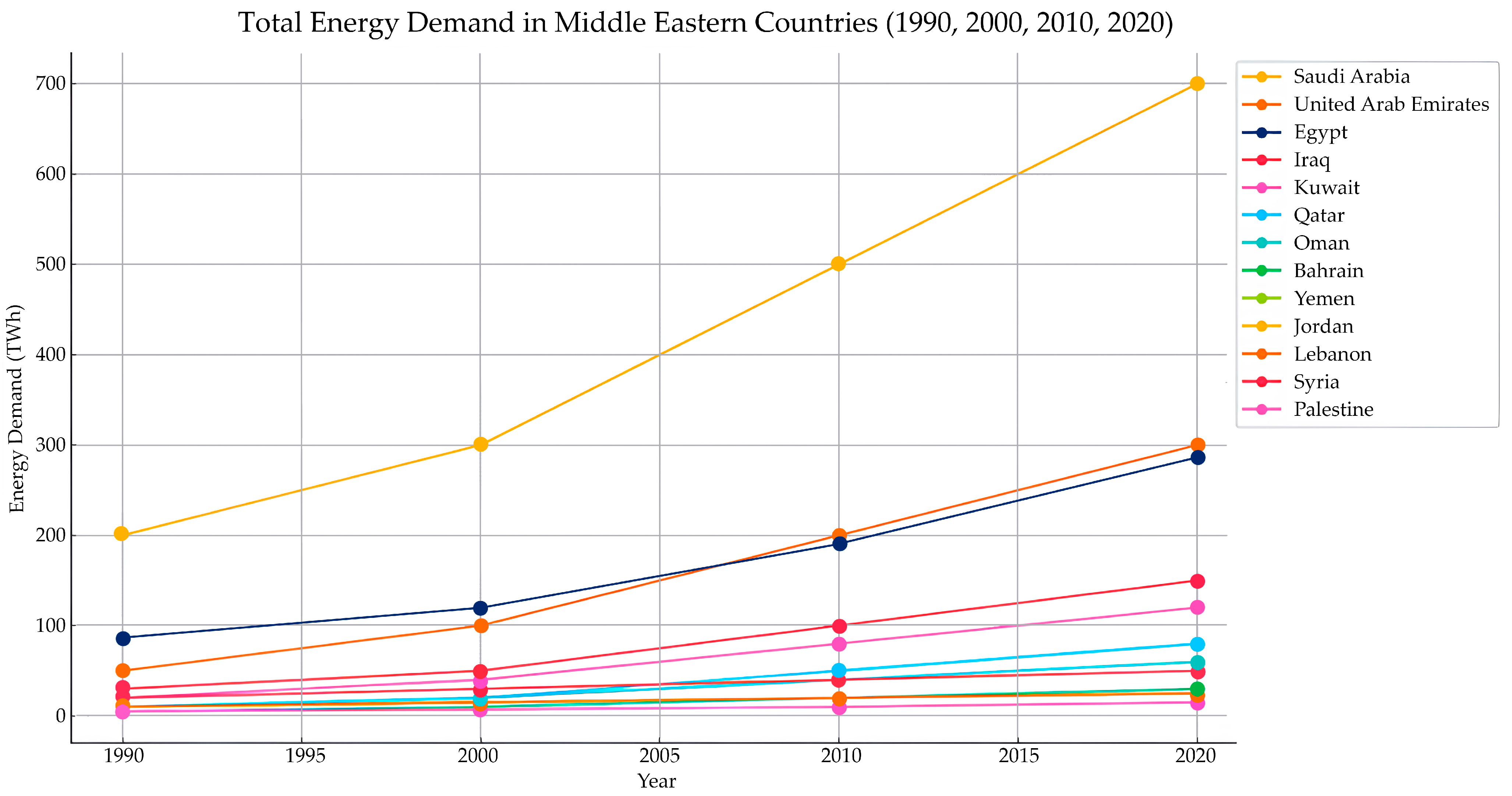
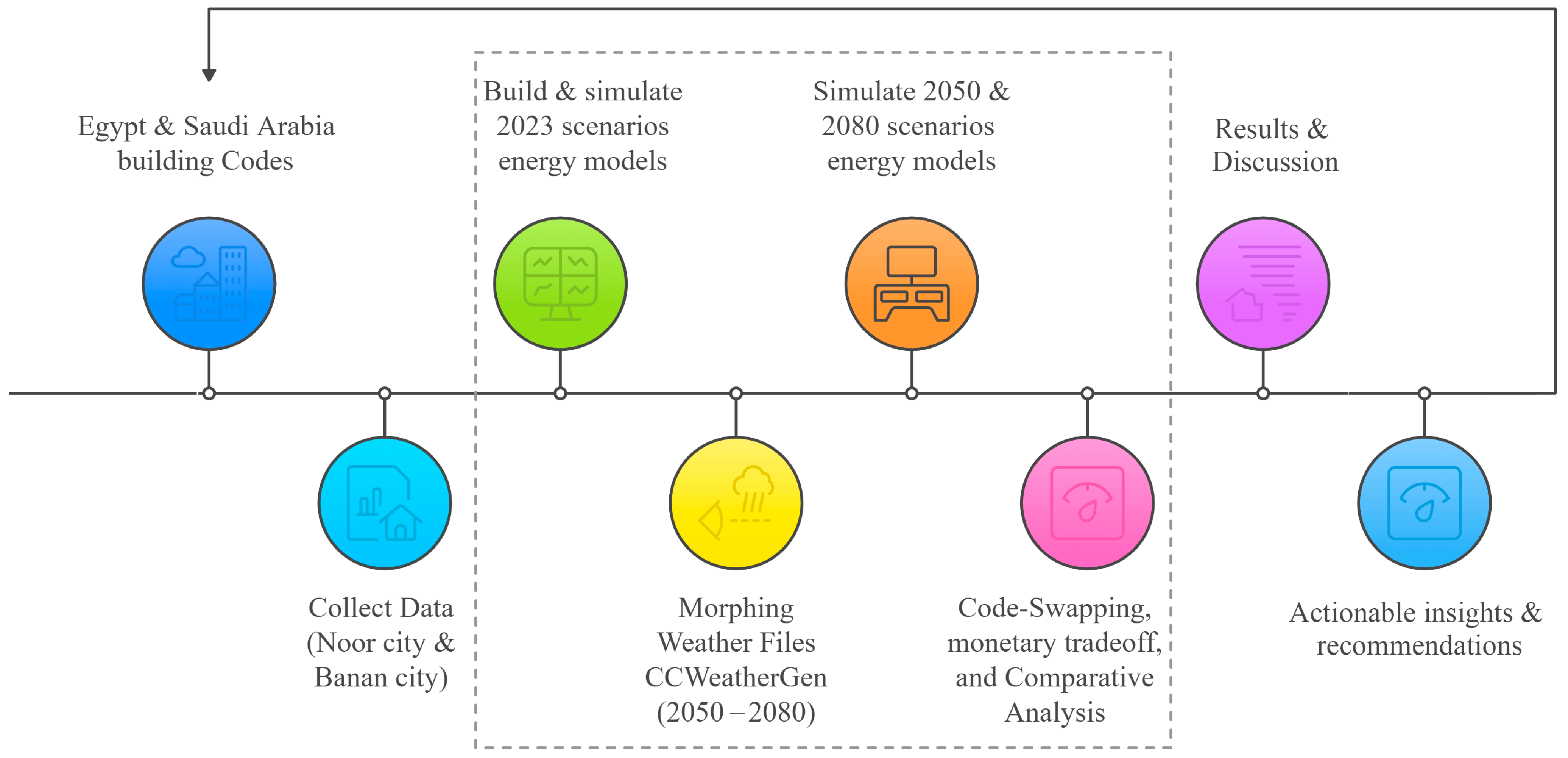
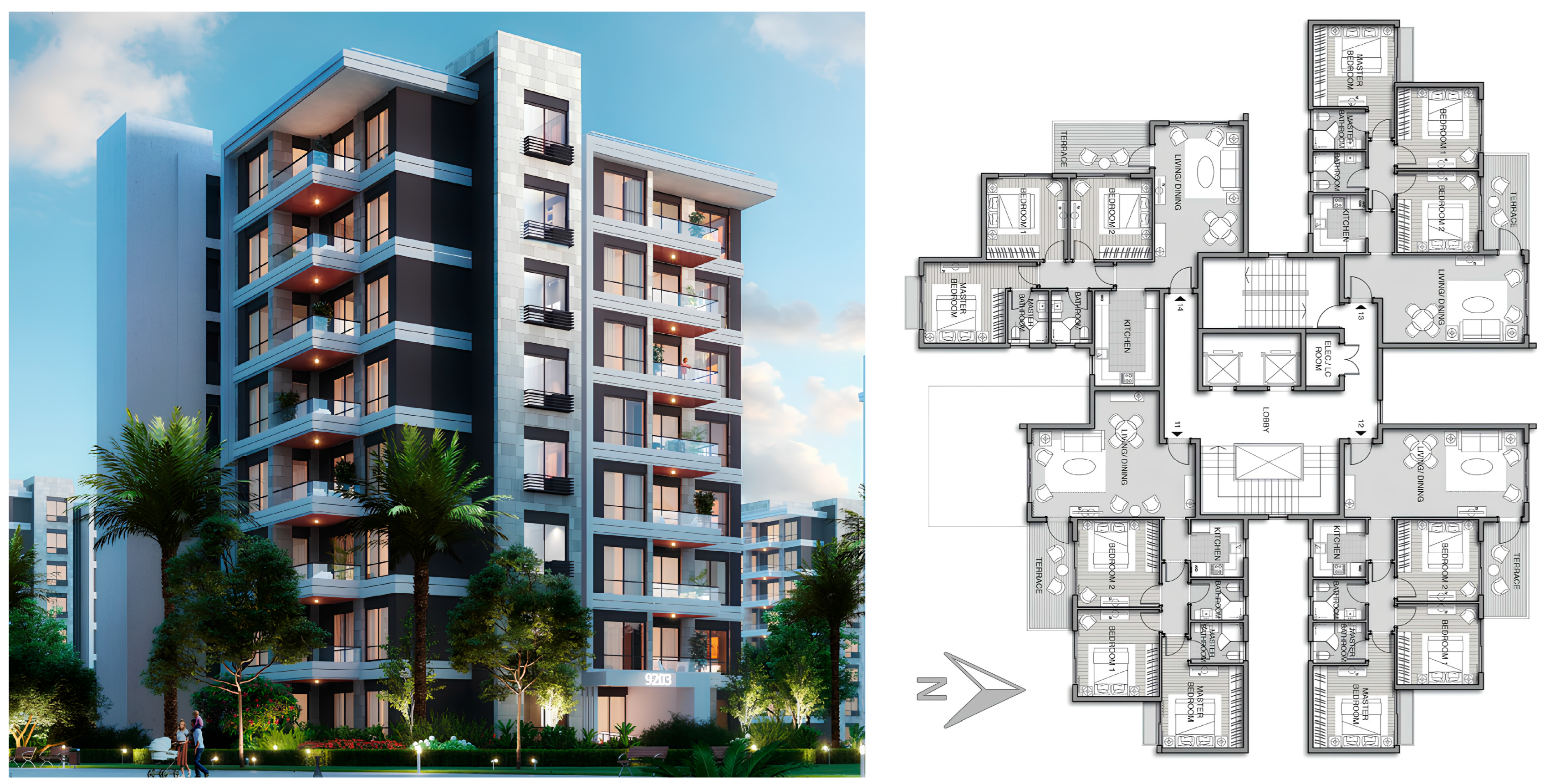
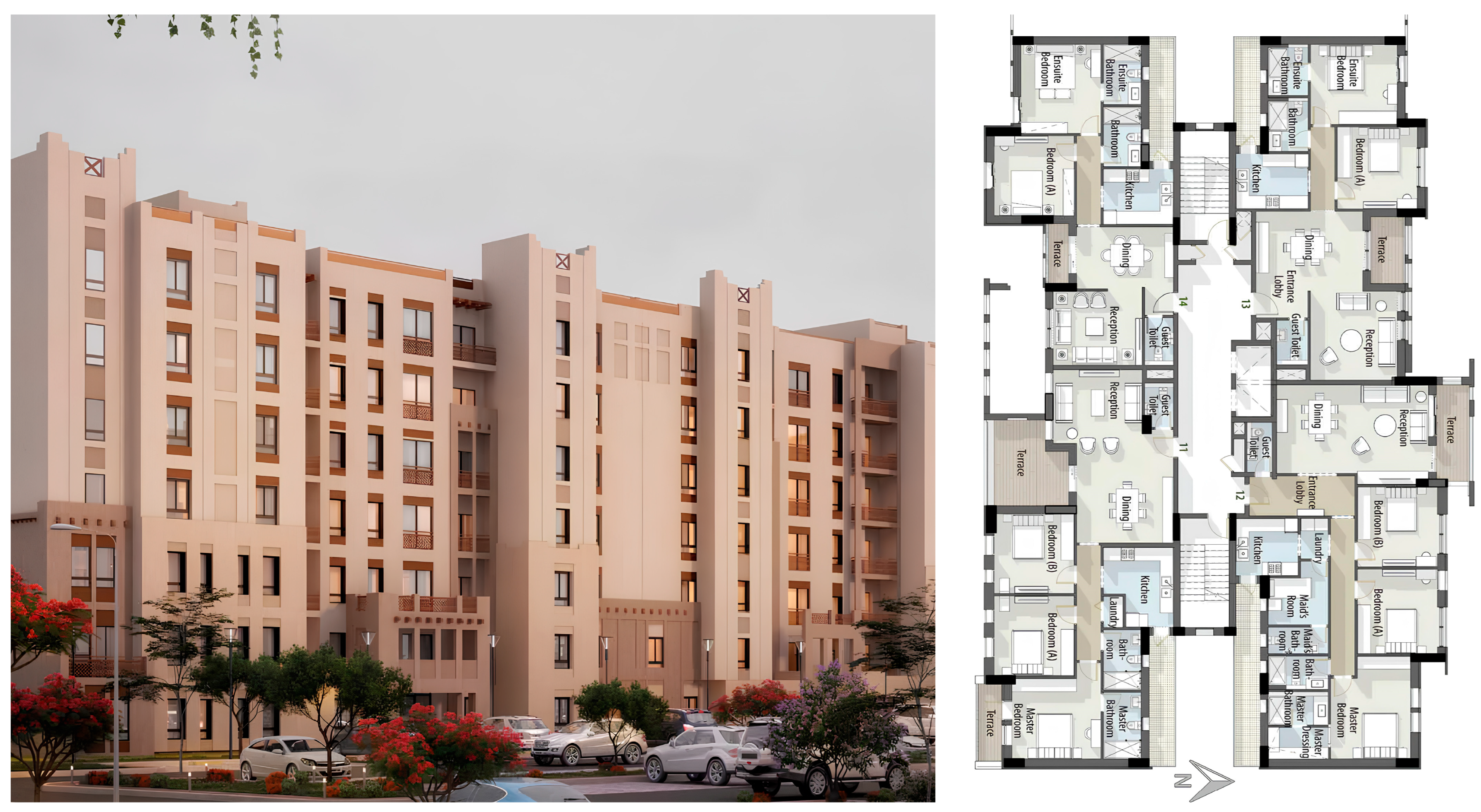

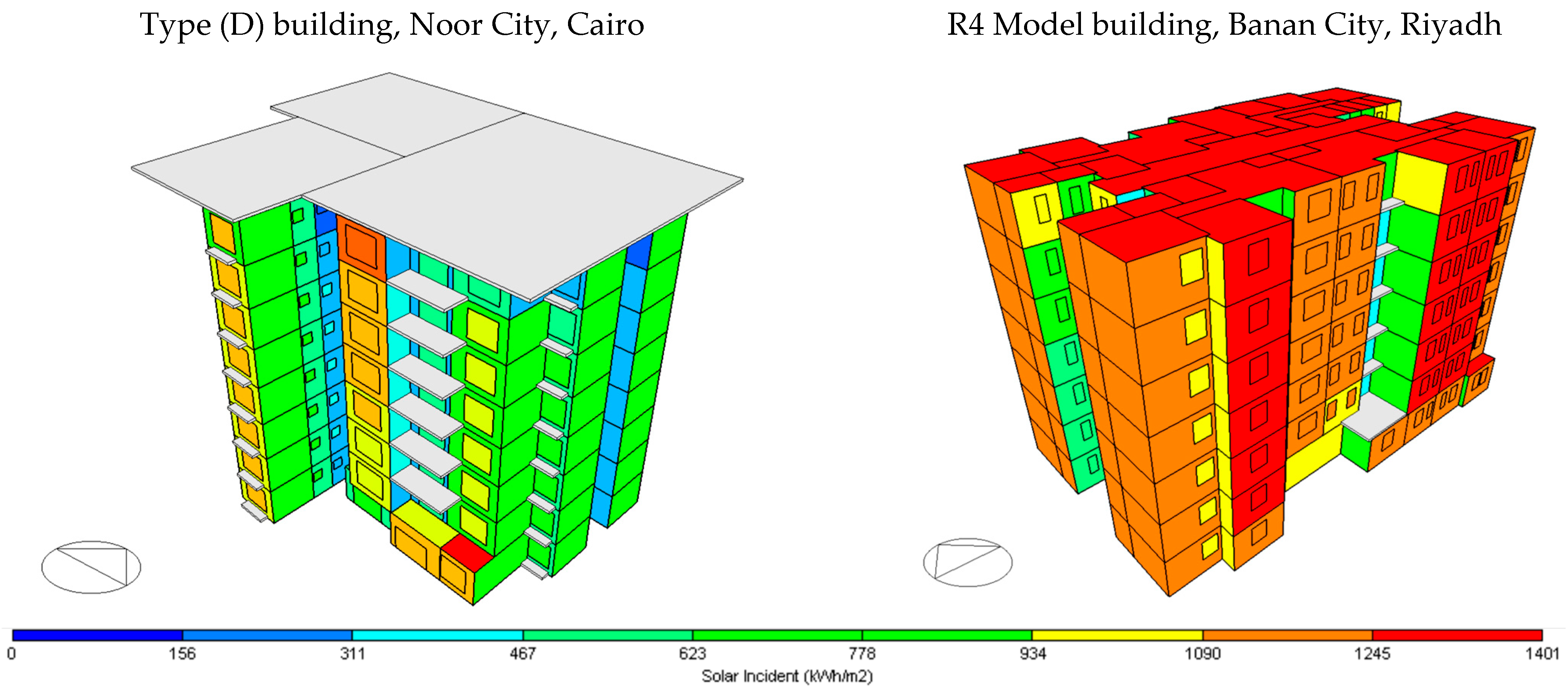
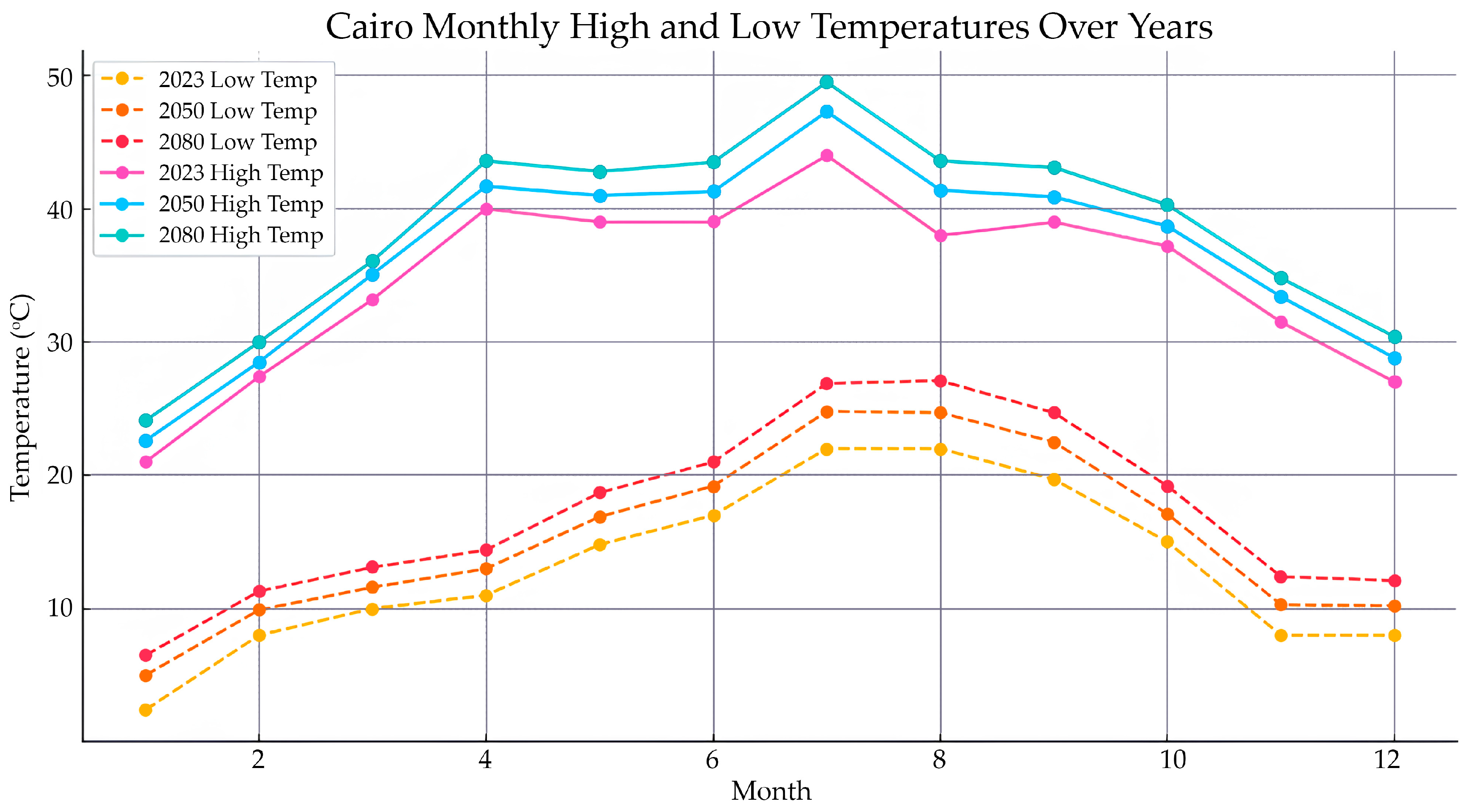
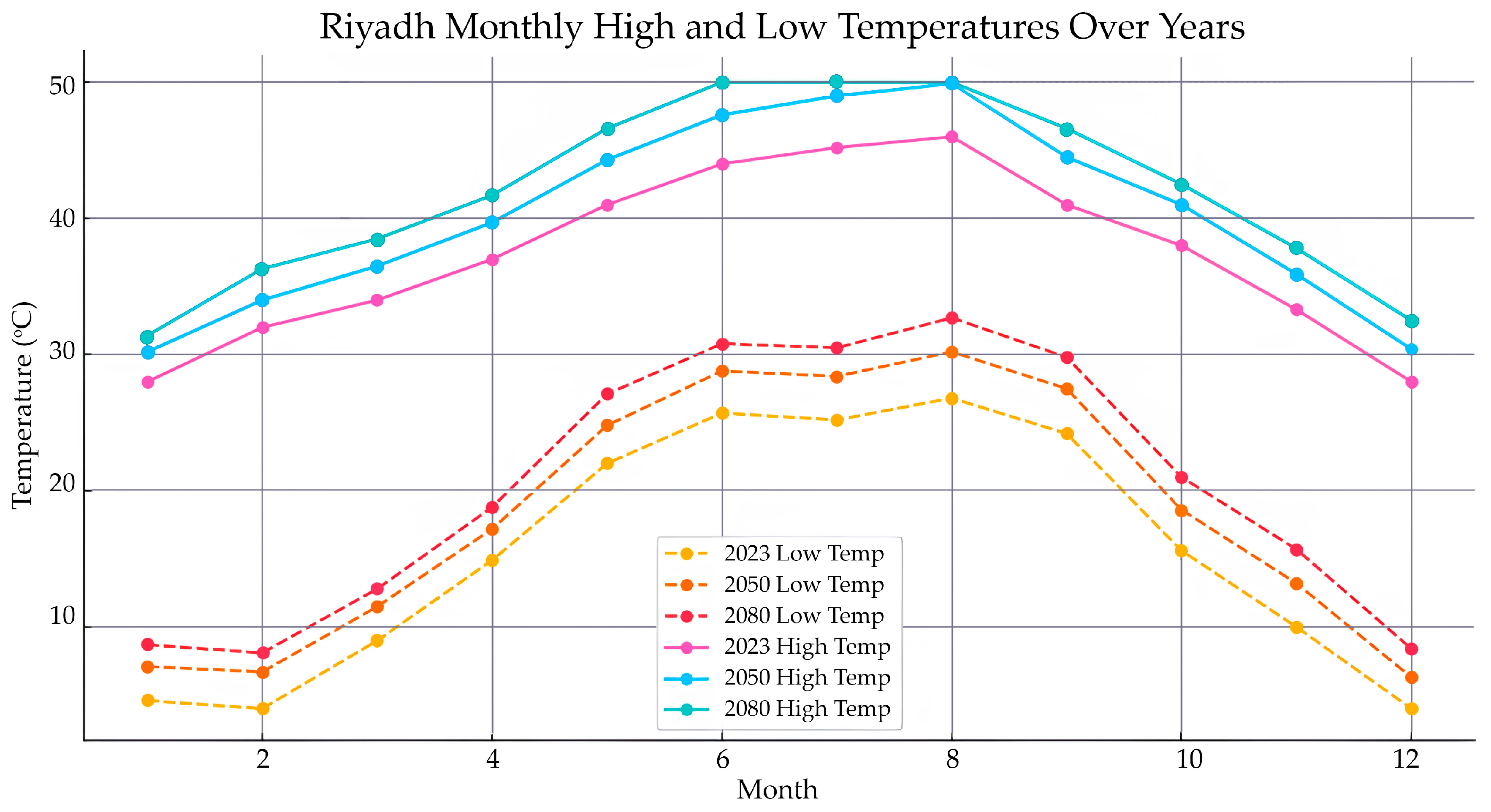
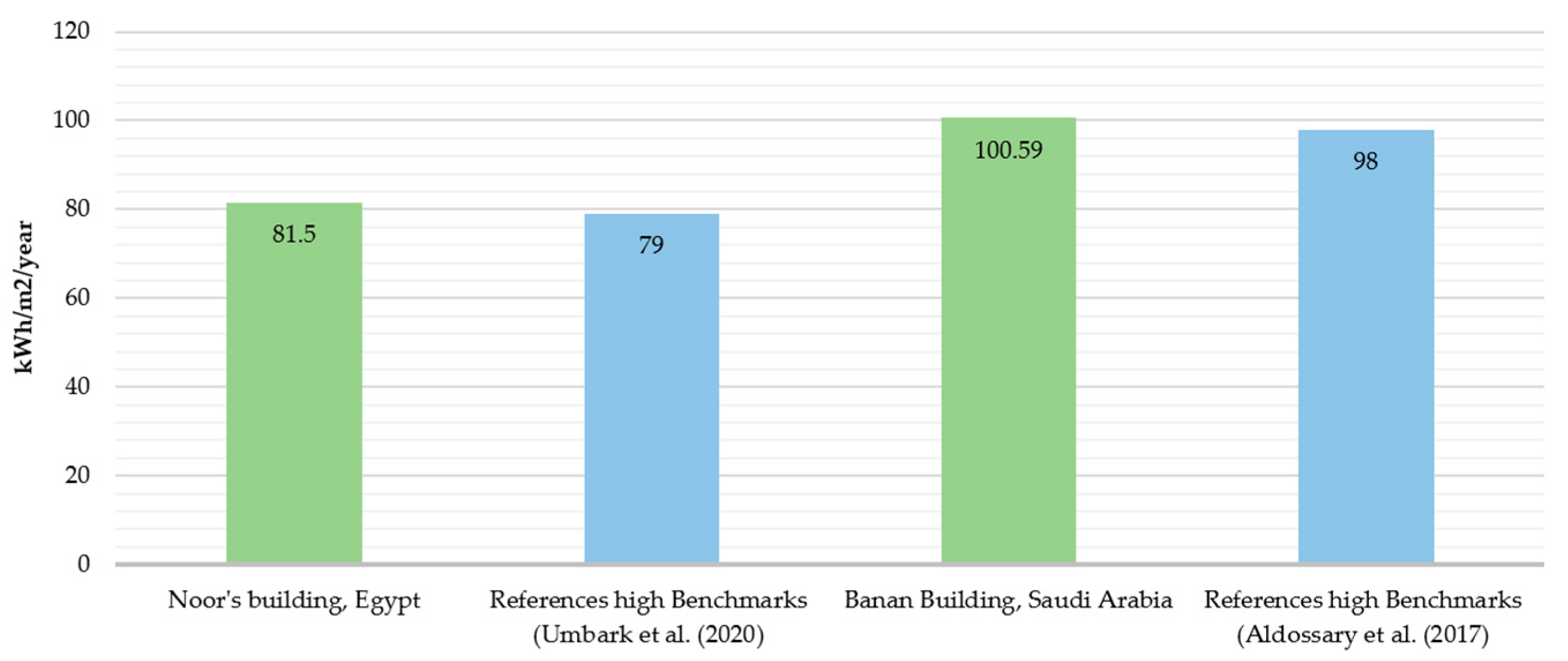
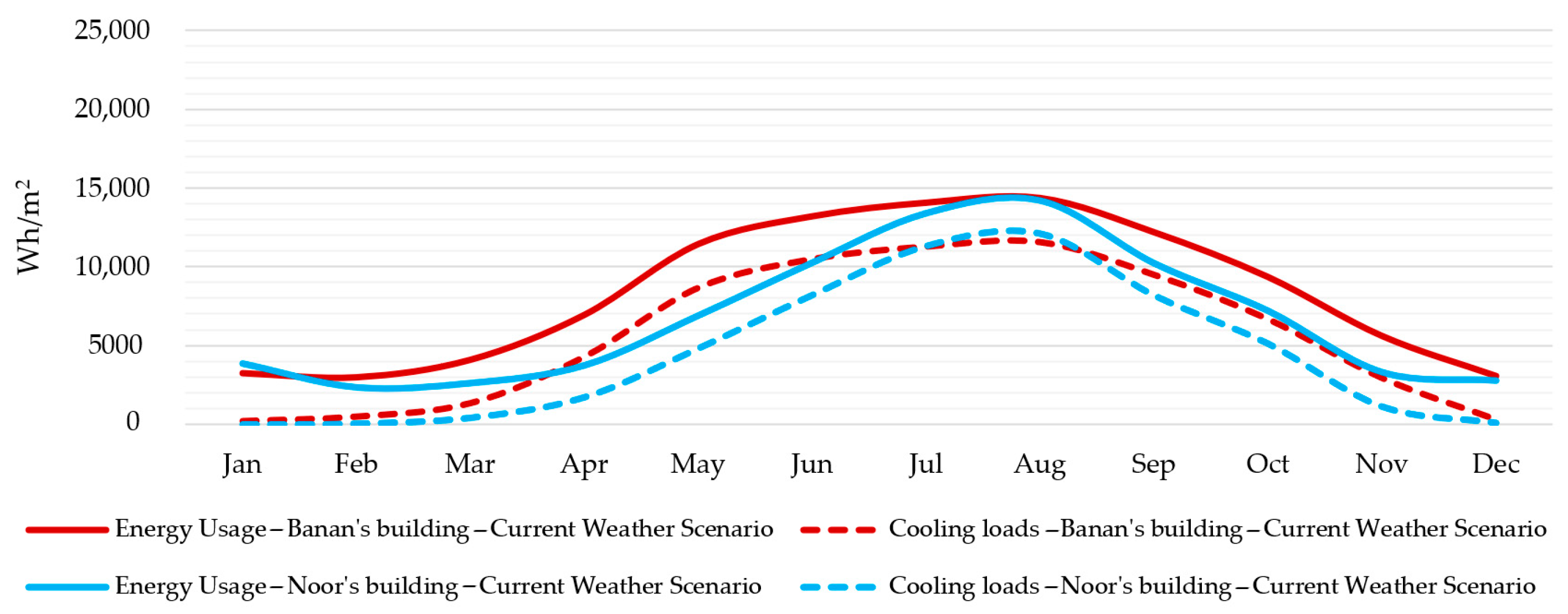
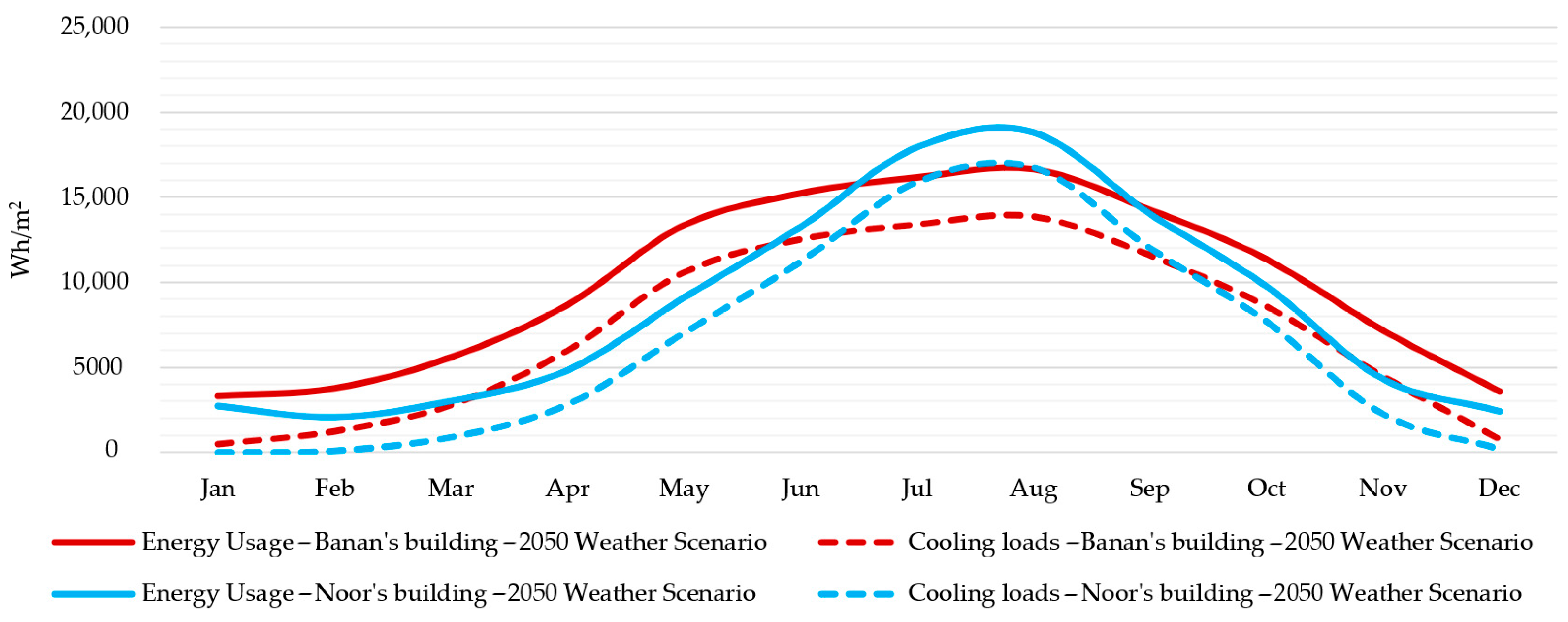

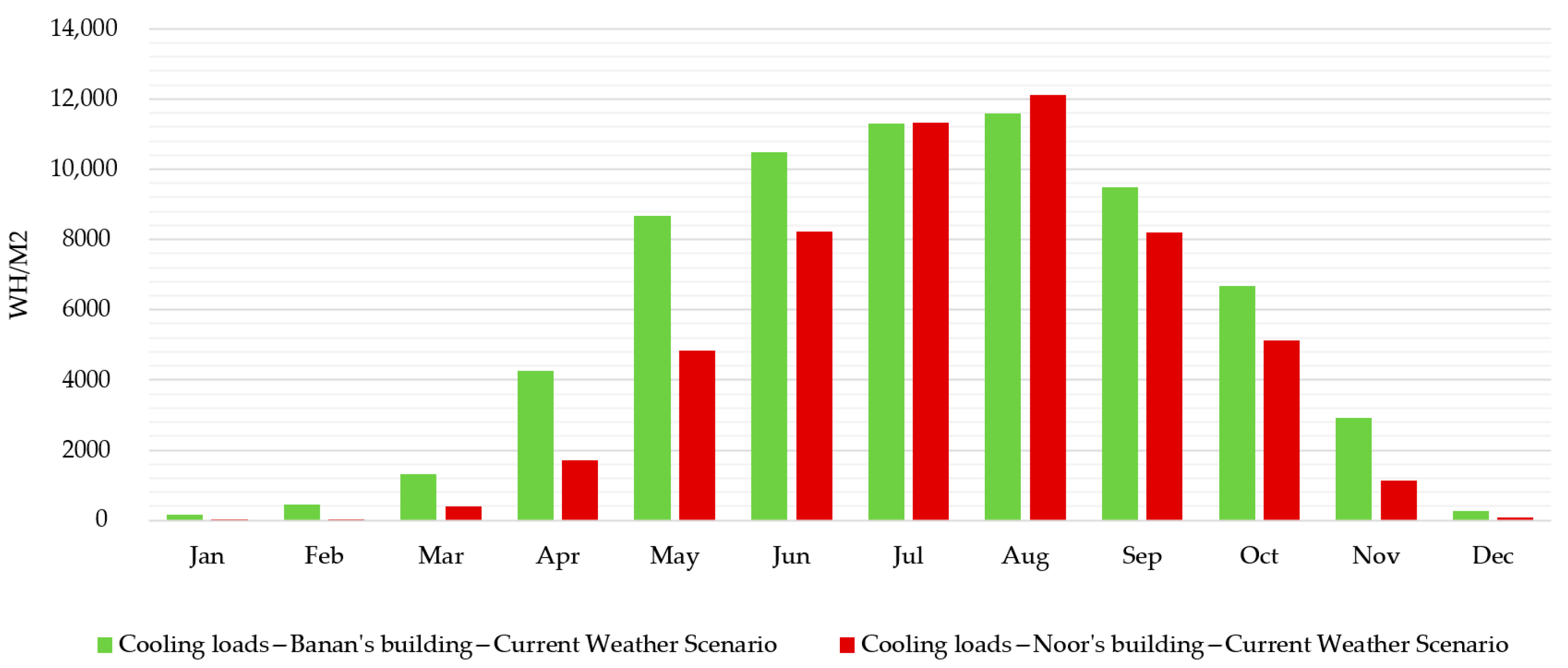
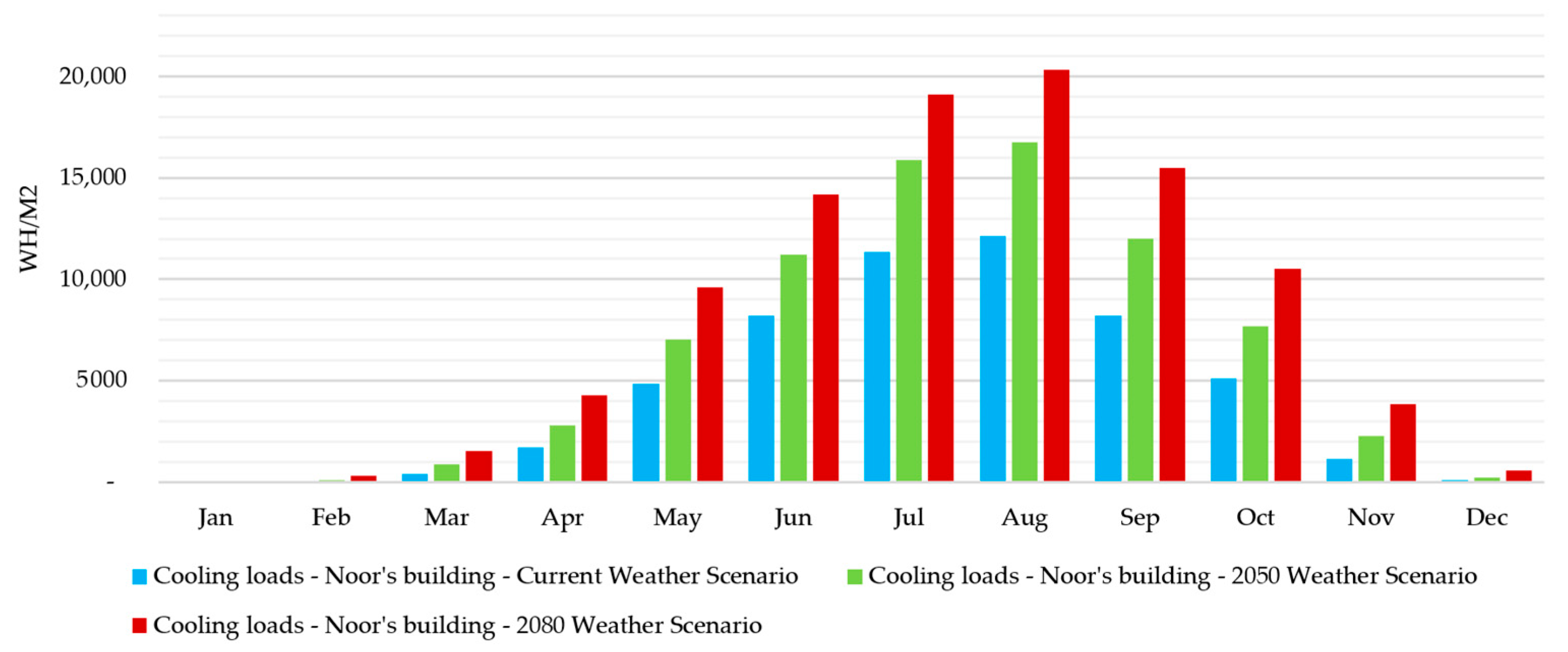
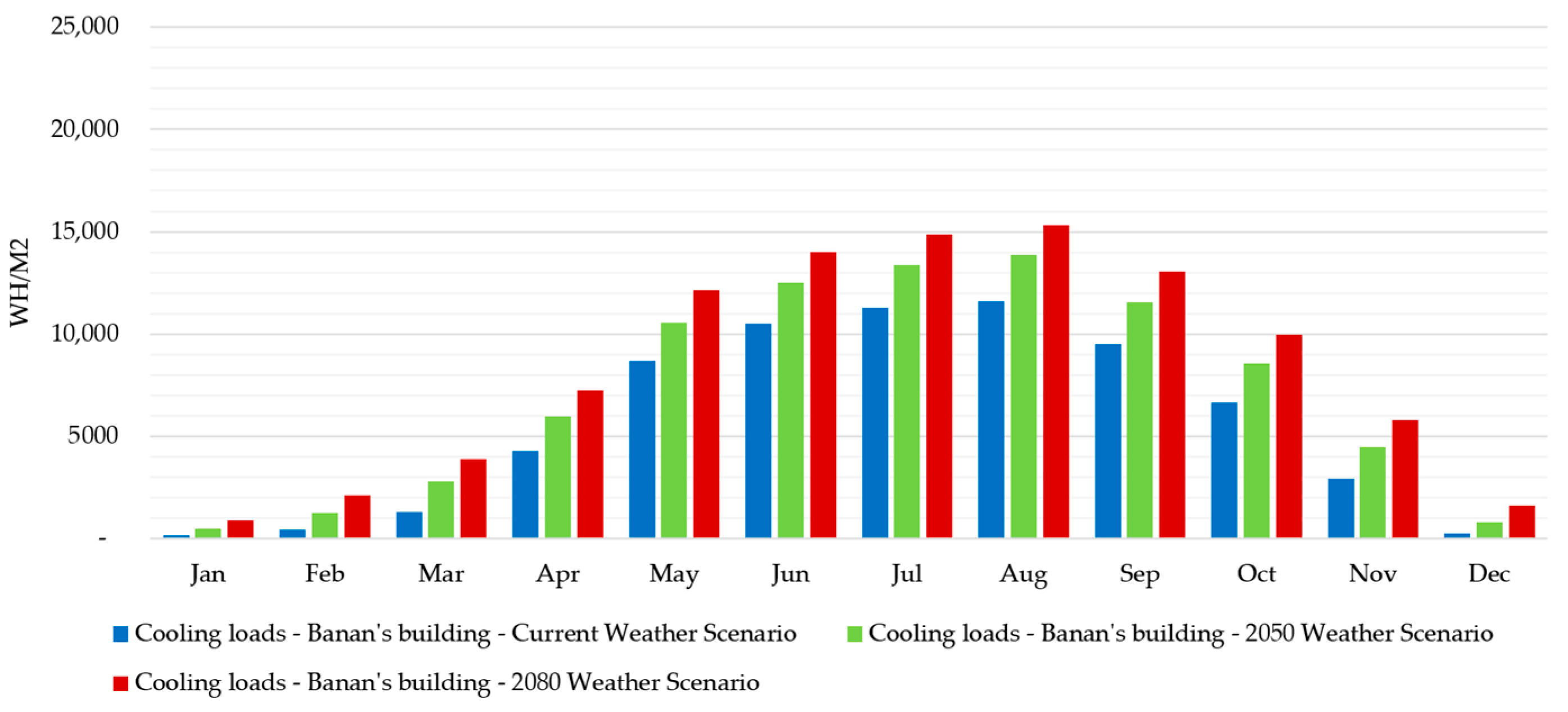

| Factor | Description |
|---|---|
| Building Envelope | Insulation, glazing type, and materials used in walls and roofs. |
| HVAC Efficiency | The efficiency of air conditioning units and other HVAC components. |
| Occupancy Patterns | Number of occupants, activity levels, and usage of indoor spaces. |
| Local Climate | Temperature, humidity, and solar radiation levels vary by season and region. |
| Building Codes | Regional regulations for energy efficiency, insulation, and sustainable practices. |
| Climate Variable | Projected Change (RCP 4.5) |
|---|---|
| Temperature | Increase of 1.5–3 °C by 2050 |
| Humidity | Variable, with a possible increase in arid areas |
| Solar Radiation | Potential increases in solar gain levels |
| Extreme Heat Events | Increase in frequency and duration |
| Attribute | Noor City, Type D Characteristics (Egypt) | Banan City, R4 Building Characteristics (Saudi) |
|---|---|---|
| Location | Cairo, Egypt (latitude: 30.0′ N; longitude: 31.5′ E; elevation: 243 m) | Riyadh, Saudi Arabia (latitude: 24.7′ N; longitude: 46.7′ E; elevation: 620 m) |
| Building type | Multi-story residential building | Multi-story residential building |
| Floors | Ground floor + 7 typical floors (489.4 m2/floor = 3915.2 m2 total floor area) | Ground floor + 6 typical floors (557.4 m2 per floor = 3902 m2 total floor area) |
| Total units | 28 apartments (4 apartments per floor) | 24 apartments (4 apartments per floor) |
| WWR | 17.60% (690 m2) | 10.52% (349.9 m2) |
| Net external wall area | 3238.1 m2 | 3149.1 m2 |
| Unit sizes | Apartments range from approximately 60 to 152 m2, including bedrooms, bathrooms, reception areas, and kitchens | Apartments range from approximately 60 to 152 m2, including bedrooms, bathrooms, reception areas, and kitchens |
| Wall construction | 20 mm plaster (exterior) + 150 mm hollow concrete block + 20 mm plaster (interior) U-value = 0.955 | 20 mm plaster (exterior) + 150 mm hollow concrete block with 50 mm polystyrene insulation + 20 mm plaster (interior) U-value = 0.353 |
| Roof construction | 25 mm roofing tiles + 25 mm mortar + 10 mm sand + 320 mm concrete slab + 13 mm cement plaster U-value = 0.256 | 25 mm roofing tiles + 25 mm mortar + 10 mm sand + 50 mm polystyrene insulation + 320 mm concrete slab + 13 mm cement plaster U-value = 0.183 |
| Glazing | Single-glazed, clear frosted windows with aluminum frames | 24 mm double-glazed (6 mm glass + 12 mm air gap + 6 mm glass), clear frosted windows with aluminum frames |
| Air infiltration | 0.8 air changes per hour (ACH) | 0.8 air changes per hour (ACH) |
| HVAC system | Split air conditioning units; Coefficient of Performance (COP): 4.0; cooling set points: 24 °C to 28 °C; no fresh air unit | Split air conditioning units; Coefficient of Performance (COP): 4.0; cooling set points: 24 °C to 28 °C; no fresh air unit |
| Lighting power | 3.3 W/m2, using LED lighting | 3.3 W/m2, using LED lighting |
| Equipment power density | 5.0 W/m2 across all living areas | 5.0 W/m2 across all living areas |
| Domestic hot water | Stand-alone electric water heater, 11.4 L/person/day, with a COP of 0.85 | Stand-alone electric water heater, 11.4 L/person/day, with a COP of 0.85 |
| Occupancy assumption | 6 residents per apartment (2 adults, 4 children), aligned with typical Egyptian residential occupancy patterns | 6 residents per apartment (2 adults, 4 children), aligned with typical Saudi residential occupancy patterns |
| Parameter | Current Scenario | 2050 Projection (RCP 4.5) | 2080 Projection (RCP 4.5) |
|---|---|---|---|
| Average Temperature Increase | Baseline (DesignBuilder weather data) | +1.5 °C to +2 °C | +2.5 °C to +3 °C |
| Other Variables | Unchanged (based on current data) | Unchanged | Unchanged |
| Case Study | WWR (%) | Wall U-Value (W/m2·K) | Roof U-Value (W/m2·K) | Glazing Type |
|---|---|---|---|---|
| Noor (Egyptian Code) | 17.6 | 0.955 | 0.256 | Single-Glazed |
| Noor (Saudi Code) | 10.52 | 0.353 | 0.183 | Double-Glazed |
| Banan (Saudi Code) | 10.52 | 0.353 | 0.183 | Double-Glazed |
| Banan (Egyptian Code) | 17.6 | 0.955 | 0.256 | Single-Glazed |
| Case Study | Code Applied | 2023 | 2050 | 2080 | |||
|---|---|---|---|---|---|---|---|
| Energy Usage (kWh) | Cost (USD) | Energy Usage (kWh) | Cost (USD) | Energy Usage (kWh) | Cost (USD) | ||
| Noor | Egyptian Code | 319,068 | 12,443 | 404,001 | 15,756 | 492,403 | 19,203 |
| Saudi Code | 191,013 | 7449 | 239,450 | 9338 | 285,574 | 11,137 | |
| Banan | Saudi Code | 392,493 | 22,764 | 464,359 | 26,933 | 521,121 | 30,225 |
| Egyptian Code | 572,429 | 33,200 | 695,005 | 40,310 | 797,258 | 46,241 | |
| City | Year | Case Study Energy (kWh) | City Residential Energy (GWh) | CO₂ Emissions (Million Tons) |
|---|---|---|---|---|
| Riyadh | 2023 | 392,493.46 | 42,975.0 | 293.4 |
| 2050 | 464,359.65 | 50,843.8 | 347.2 | |
| 2080 | 521,121.04 | 57,058.7 | 389.6 | |
| Cairo | 2023 | 319,068.68 | 18,612.06 | 127.3 |
| 2050 | 404,001.12 | 23,566.38 | 161.2 | |
| 2080 | 492,403.69 | 28,723.12 | 196.4 |
| 2023 Scenario | 2050 Scenario | 2080 Scenario | ||||
|---|---|---|---|---|---|---|
| Energy Consumption Without PV Cells (Wh/m2) | Energy Consumption with PV Cells (Wh/m2) | Energy Consumption Without PV Cells (Wh/m2) | Energy Consumption with PV Cells (Wh/m2) | Energy Consumption Without PV Cells (Wh/m2) | Energy Consumption with PV Cells (Wh/m2) | |
| Noor model, Egypt | 80,756.43 | 55,146.03 | 102,252.87 | 77,401.67 | 124,627.61 | 99,531.51 |
| Banan model, Saudi | 100,587.76 | 65,162.22 | 119,005.54 | 83,232.44 | 133,552.29 | 97,624.29 |
Disclaimer/Publisher’s Note: The statements, opinions and data contained in all publications are solely those of the individual author(s) and contributor(s) and not of MDPI and/or the editor(s). MDPI and/or the editor(s) disclaim responsibility for any injury to people or property resulting from any ideas, methods, instructions or products referred to in the content. |
© 2025 by the authors. Licensee MDPI, Basel, Switzerland. This article is an open access article distributed under the terms and conditions of the Creative Commons Attribution (CC BY) license (https://creativecommons.org/licenses/by/4.0/).
Share and Cite
Aloshan, M.A.; Aldali, K. The Role of Regional Codes in Mitigating Residential Sector Energy Demand Sensitivity to Climate Change Scenarios in Hot–Arid Regions. Buildings 2025, 15, 1789. https://doi.org/10.3390/buildings15111789
Aloshan MA, Aldali K. The Role of Regional Codes in Mitigating Residential Sector Energy Demand Sensitivity to Climate Change Scenarios in Hot–Arid Regions. Buildings. 2025; 15(11):1789. https://doi.org/10.3390/buildings15111789
Chicago/Turabian StyleAloshan, Mohammed A., and Kareem Aldali. 2025. "The Role of Regional Codes in Mitigating Residential Sector Energy Demand Sensitivity to Climate Change Scenarios in Hot–Arid Regions" Buildings 15, no. 11: 1789. https://doi.org/10.3390/buildings15111789
APA StyleAloshan, M. A., & Aldali, K. (2025). The Role of Regional Codes in Mitigating Residential Sector Energy Demand Sensitivity to Climate Change Scenarios in Hot–Arid Regions. Buildings, 15(11), 1789. https://doi.org/10.3390/buildings15111789






